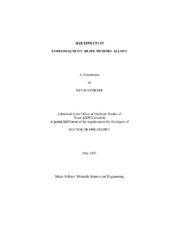| dc.contributor.advisor | Karaman, Ibrahim | |
| dc.creator | Ozdemir, Nevin | |
| dc.date.accessioned | 2012-07-16T15:57:33Z | |
| dc.date.accessioned | 2012-07-16T20:27:29Z | |
| dc.date.available | 2014-09-16T07:28:19Z | |
| dc.date.created | 2012-05 | |
| dc.date.issued | 2012-07-16 | |
| dc.date.submitted | May 2012 | |
| dc.identifier.uri | https://hdl.handle.net/1969.1/ETD-TAMU-2012-05-10735 | |
| dc.description.abstract | The utilization of ferromagnetic shape memory alloys (FSMAs) in small scale devices has attracted considerable attention within the last decade. However, the lack of sufficient studies on their reversible shape change mechanisms, i.e, superelasticity, magnetic field-induced martensite variant reorientation and martensitic phase transformation, at the micron and submicron length scales prevent the further development and the use of FSMAs in small scale devices. Therefore, investigating the size effects in these mechanisms has both scientific and technological relevance.
Superelastic behavior of Ni54Fe19Ga27 shape memory alloy single crystalline pillars was studied under compression as a function of pillar diameter. Multiple pillars with diameters ranging between 200 nm and 10 µm were cut on a single crystalline bulk sample oriented along the [110] direction in the compression axis and with fully reversible two-stage martensitic transformation. The results revealed size dependent two-stage martensitic transformation which was suppressed for pillar sizes of 1 µm and below. We also demonstrated that the reduction in pillar diameter decreases the transformation temperature due to the difficulty of martensite nucleation in small scales.
Size effects in the magnetic field-induced martensite variant reorientation were investigated in the Ni50Mn28.3Ga21.7 single crystals oriented along the [100] direction of the austenite phase. Single crystalline compression pillars were fabricated on the martensite twins between the sizes of 630 nm and 20 µm. It was found that the stress-induced and magnetic field-induced martensite variant reorientation are size dependent and became more difficult with the reduction in sample size. Surprisingly, it was still possible to magnetically activate the shape change in the micropillars which indicates the fact that magnetocrystalline anisotropy energy increases with the reduction in sample dimensions.
Ni45Mn36.6Co5In13.4 pillars between the 600 nm and 10 µm diameters were investigated along the [100] direction of the austenite to study the size effects in the magnetic field-induced phase transformation (MFIPT). MFIPT was obtained down to 5 µm size in these pillars with reasonable magnetic field levels similar to their bulk counterparts. | en |
| dc.format.mimetype | application/pdf | |
| dc.language.iso | en_US | |
| dc.subject | Shape memory alloys | en |
| dc.subject | Martensitic transformation | en |
| dc.subject | Plastic deformation | en |
| dc.subject | Micropillars | en |
| dc.subject | Focused ion beam | en |
| dc.subject | Magnetic Field-induced Martensite Variant Reorientation | en |
| dc.subject | Magnetic Field-induced Phase Transformation | en |
| dc.title | Size Effects in Ferromagnetic Shape Memory Alloys | en |
| dc.type | Thesis | en |
| thesis.degree.department | Aerospace Engineering | en |
| thesis.degree.discipline | Materials Science and Engineering | en |
| thesis.degree.grantor | Texas A&M University | en |
| thesis.degree.name | Doctor of Philosophy | en |
| thesis.degree.level | Doctoral | en |
| dc.contributor.committeeMember | Hartwig, K. Ted | |
| dc.contributor.committeeMember | Zhang, Xinghang | |
| dc.contributor.committeeMember | Cagin, Tahir | |
| dc.type.genre | thesis | en |
| dc.type.material | text | en |
| local.embargo.terms | 2014-07-16 | |


